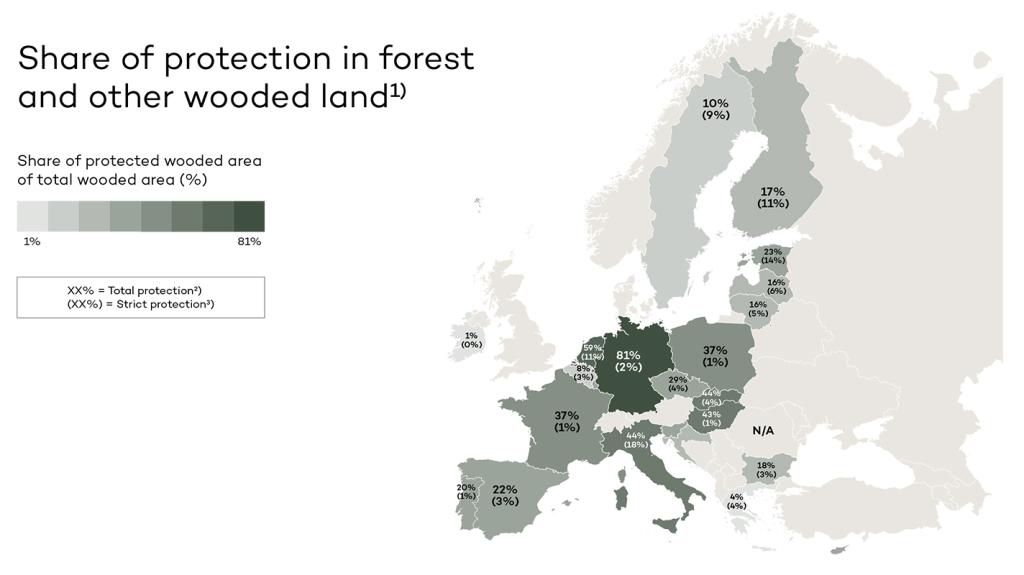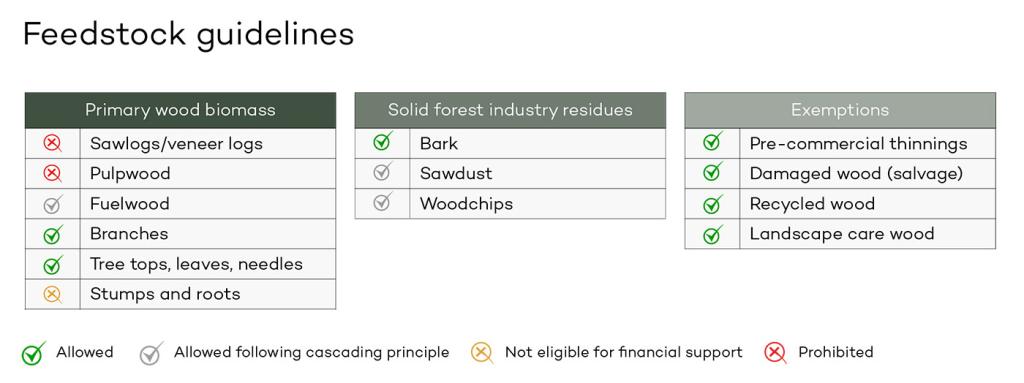
Potential impacts of EU policies on biomass supply and markets
Changes in the policy landscape are to significantly impact European biomass markets
Fit for 55 policies are foreseen to greatly impact sustainable forest management and biomass supply in EU countries.

– Forestry strategy
– LULUCF
– Nature restoration
– RED III
– Sustainable carbon cycles
The biodiversity strategy targets expanding protection areas
The strategy may significantly restrict biomass supply, which shall depend on implementation at the national level. The strategy may restrict biomass availability through increased protection of forest land, including remaining primary and old-growth forests. To what degree biomass availability will be impacted depends on the current protection level and whether the protection targets are implemented fully in each Member State or in the EU as a whole. Biodiversity Strategy is not legally binding, and Member States are not obliged to enforce the targets.
The share of protected forests 1 is significantly higher in Central Europe compared to the Baltic Sea region but clearly lower when it comes to strict protection 2, 3 . Although the share of protected forest land is relatively high in Central Europe, the share of strictly protected forests is remarkably higher in the Nordics.

Nature Restoration Proposal introduces legally binding targets for ecosystem restoration
Nature Restoration Proposal will probably decrease biomass availability, but it is unclear to what extent. The Commission Proposal would have the most significant impact on biomass availability, the Council Proposal a moderate impact and the Parliament proposal the lowest impact.
The key factor defining the policy's impacts on biomass availability is the need for additional habitat areas to reach the favourable reference area for each habitat type. Member States will define actual needs for restoration in restoration plans, which will be submitted to the Commission.
LULUCF targets put pressure to restrict wood harvesting at the national level
If Member States cannot decrease emissions from other land categories than forests, they may be forced to reduce wood harvesting to compensate for emissions in other sectors. Decreased harvesting will mean less wood supply for wood industries and less forest-based biomass for bioenergy.
The LULUCF targets are binding at the national level but do not directly impact individual forest owners. Their impact on biomass supply will depend on potential policies or restrictions set by the member states.
While the set-up and targets of LULUCF (and ETS) are defined up to 2030, the climate policy architecture beyond 2030 is still uncertain.
Forest Strategy includes elements with positive and negative impacts
The emphasis of the EU forest strategy seems to be on elements that negatively impact the biomass supply. It may restrict biomass availability, suggesting significant changes to forest management practices. For example, clear-cuts are advised against, and continuous cover forestry is promoted. Some Nordic studies indicate a yield reduction of around 20% in the continuous cover forestry stands compared to clearcut and planted stands.
Even though the strategy also promotes the planting of three billion additional trees by 2030, they are not meant to be used in the forest industry. Recommendations that would reduce the productivity of forests are not aligned with the objectives to promote sustainable bioeconomy and wood-based construction.
Recently adopted RED III regulation shall allow the use of typical feedstocks by the bioenergy sector, having limited impact on biomass availability
Under the regulation, forest supply harvesting residues and round fuelwood are allowed, as is wood from pre-commercial thinnings, damaged wood and landscape care wood.
Regarding residue supply, bark, woodchips and sawdust, they all are allowed based on the cascading principle. However, both assortments may have alternative uses in wood-based panels and pulp sectors. Additionally, recycled wood is allowed.
Potential flexibilities include any further changes that may be implemented during the rollout of legislation by each member state. Member states can deviate from official cascading principles due to market specifics.

Sustainable Carbon Cycles initiative is targeting to accelerate the development of voluntary markets for forest carbon credits
Funding and standardisation of CF by the EU is targeted to accelerate the development of voluntary carbon markets. Carbon credits could become an additional product that forest owners could sell, and a high price level for CF credits would lead to changes in forest management, potentially curtailing biomass supply.

– Deforestation-free products
– EU Taxonomy
Impacts of other policies on European biomass markets are more indirect
The carbon border adjustment mechanism impacts the EU biomass markets through the competitiveness of EU vs. non-EU companies. The regulation on deforestation-free forest products increases monitoring and bureaucracy regarding biomass products while introducing an import ban on land conversion-based products. Finally, the EU Taxonomy affects companies operating in the EU through its enhanced sustainability criteria for financing.
EU policies are foreseen to restrict the biomass availability for energy and industry sectors
The overall impact of the EU’s Fit for 55 policies on biomass supply is mostly negative, which conflicts with the objectives to promote sustainable bioeconomy and wood-based construction. Furthermore, overlapping policies make it challenging to quantify the combined impact.
Significant uncertainties remain on how member states will eventually implement the policies, which will define the actual impact. Contributing to the unclarity, several policies are not legally binding, and some key terms still lack exact definitions.
Full implementation of policies could result in major biomass shortages in several member states. Therefore, the situation needs to be carefully monitored for further evolution of these policies and their impacts.

Bioindustry Management Consulting
Bio-based alternatives and a circular economy approach have increased in their importance and are becoming the new norm. To survive and flourish, industries and companies need to adapt and innovate at an ever-increasing rate. This generates a growing and exciting market for our consulting services.




